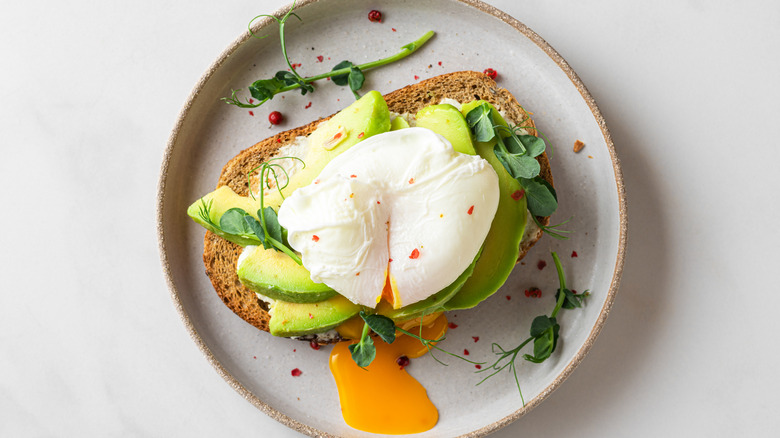Jamie Oliver's Trick To Poaching Older Eggs Is Genius
Poached eggs are great for a quick and easy weekday breakfast. They're also ideal for leisurely weekend breakfasts, perhaps dressed with some easy Hollandaise sauce and sautéed spinach or asparagus. However, if your poached eggs look like wispy blobs with disconnected, stringy whites floating in the water, they might not be as fresh. No worries, Jamie Oliver — king of kitchen hacks — has a genius trick for you.
Crack your egg in a ramekin and set your water to boil before turning it down to a bare simmer. Stir the water so it's going at a good rate and looks like a mini-whirlpool. Drop your egg into the middle of the vortex and watch as the wispy whites solidify and swirl around the yolk. The whites will still be a little wispy but not as tragic as if you had just dropped in the egg. The trick works because the movement of the water prevents the whites from spreading. The water has to be going quite quickly. Otherwise, the white won't envelop the yolk. You can watch Oliver demonstrate the hack on his YouTube channel.
Poaching eggs this way does mean you need to cook the eggs one at a time. So, if you're making poached eggs for two people, you'll need to time it perfectly or use two pots.
Older eggs are still perfectly suitable for poaching
Older eggs are a fine choice for poached eggs but require more forethought. Beyond creating a whirlpool in your pan, you can try other techniques to ensure tasty poached eggs. You can strain your egg through a fine mesh sieve – the looser, watery whites will separate from the yolk and firmer whites. Some recommend using vinegar in the poaching water to help solidify the whites, but don't overdo it: You don't want chalky egg whites or a vinegary-tasting egg.
Older eggs get wispy because, as eggs age, the albumens (the egg whites) become thin and watery. You can see this if you crack a fresh egg and an old egg next to each other on a flat surface. The fresher egg white will be thick and stay around the yolk, whereas a less fresh egg will look like it's sitting in water. Prevent eggs from aging too quickly by storing them in the refrigerator — but you shouldn't be storing eggs in those trendy plastic containers.
You can test eggs for freshness by either checking the pack date on the carton, which usually refers to the date when the hen laid the eggs, or doing the water test. Gently place an egg in a bowl of water. Fresh eggs will sink and lay horizontally. Slightly older eggs will stand upright at the bottom of the bowl. Eggs that float have gone bad and shouldn't be used.

